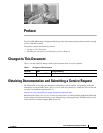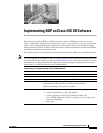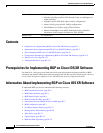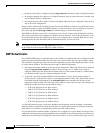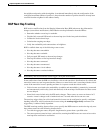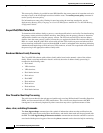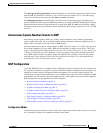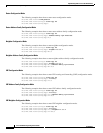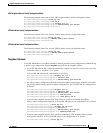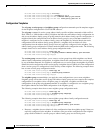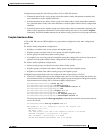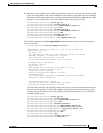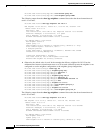
Implementing BGP on Cisco IOS XR Software
Information About Implementing BGP on Cisco IOS XR Software
RC-7
Cisco IOS XR Routing Configuration Guide
OL-14356-01
The clear bgp nexthop registration command performs an asynchronous registration of the next hop
with the RIB. See the BGP Commands on Cisco IOS XR Software module of Cisco IOS XR Routing
Commands for information on the next-hop show and clear commands.
The debug bgp nexthop command displays information on next-hop processing. The
out keyword
provides debug information only about BGP registration of next hops with RIB. The in keyword displays
debug information about next-hop notifications received from RIB. The out keyword displays debug
information about next-hop notifications sent to the RIB. See BGP Debug Commands on Cisco IOS XR
Software.
Autonomous System Number Formats in BGP
Autonomous system numbers (ASNs) are globally unique identifiers used to identify autonomous
systems (ASs) and enable ASs to exchange exterior routing information between neighboring ASs. A
unique ASN is allocated to each AS for use in BGP routing.
Currently, ASNs are encoded as 2-byte numbers in BGP. The 2-byte range is 1 to 65535. To prepare for
the eventual exhaustion of 2-byte ASNs, BGP has the capability to support 4-byte ASNs. The 4-byte
range is 1.0 to 65535.65535 and the format is high-order 16-bit value in decimal . low-order 16-bit value
in decimal. The BGP 4-byte ASN capability is used to propagate 4-byte-based AS path information
across BGP speakers that do not support 4-byte AS numbers. This capability allows for the gradual
transition from 2-byte ASNs to 4-byte ASNs. See draft-ietf-idr-as4bytes-12.txt for information on
increasing the size of an ASN from 2 bytes to 4 bytes.
BGP Configuration
Cisco IOS XR BGP follows a neighbor-based configuration model that requires that all configurations
for a particular neighbor be grouped in one place under the neighbor configuration. Peer groups are not
supported for either sharing configuration between neighbors or for sharing update messages. The
concept of peer group has been replaced by a set of configuration groups to be used as templates in BGP
configuration and automatically generated update groups to share update messages between neighbors.
BGP configurations are grouped into four major categories:
• Router Configuration Mode, page RC-8
• Router Address Family Configuration Mode, page RC-8
• Neighbor Configuration Mode, page RC-8
• Neighbor Address Family Configuration Mode, page RC-8
• VRF Configuration Mode, page RC-8
• VRF Address Family Configuration Mode, page RC-8
• VRF Neighbor Configuration Mode, page RC-8
• VRF Neighbor Address Family Configuration Mode, page RC-9
Configuration Modes
The following sections show how to enter some of the configuration modes. From a mode, you can enter
the ? command to display the commands available in that mode.



